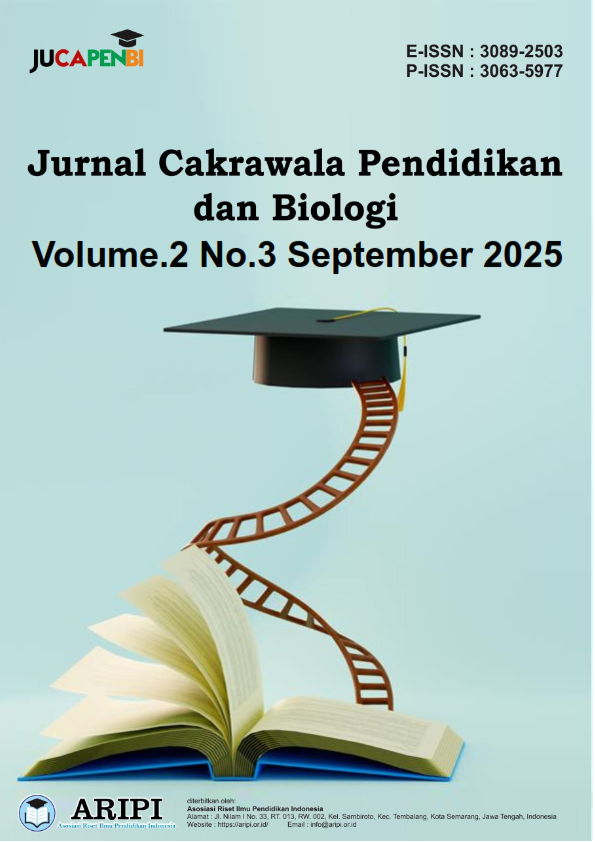Identifikasi Jamur dari Singkong (Manihot Esculenta) Berdasarkan Pewarnaan Gram dan Morfologi Koloni
DOI:
https://doi.org/10.61132/jucapenbi.v2i3.658Keywords:
Cassava, Colony Morphology, Crystal Violet, Fungi, Gram StainingAbstract
Cassava (Manihot esculenta) is a staple food rich in carbohydrates and widely consumed by people in various regions, especially in tropical regions such as Indonesia. Besides being easy to cultivate, cassava also has a high economic value. However, cassava has a major weakness, namely its perishability after harvest. This damage is often caused by contamination by microorganisms, especially fungi, which can grow rapidly in unhygienic and humid storage conditions. Fungal contamination not only causes odor and reduces sound quality but also has the potential to produce mycotoxins that are harmful to human health. Therefore, identifying the type of fungus growing on cassava is very important. The purpose of this study was to determine the presence and type of fungus growing on cassava through a colony morphology approach and Gram staining using crystal violet. The research method began with dilution of cassava samples, then inoculated into Nutrient Agar (NA) media, incubated for 48 hours at room temperature, and continued with microscopic examination. Staining with crystal violet aims to clarify the morphological structure of the fungus such as hyphae and spores. Observations revealed the growth of characteristic fungal colonies, as well as hyphal and spore structures that readily absorbed crystal violet. This demonstrates that this simple morphological and staining method is quite effective in providing initial insights into fungal identification. This information is expected to form the basis for developing safer and more durable cassava storage methods. Further research is recommended on specific identification using molecular testing. This step will broaden our understanding of the toxicological potential and post-harvest handling of cassava.
References
Afifuddin, M., Nugroho, A., & Hartono, D. (2018). Isolation and identification of fungi contaminating fermented cassava products in Indonesia. Journal of Food Safety and Microbiology, 12(3), 145–152.
Cardoso, A. P., Carvalho, L. A. M., Augusto, F., & Fhor, S. J. (2005). Processing conditions affect the nutritional quality of cassava: A review. Critical Reviews in Food Science and Nutrition, 45(9), 667–694.
Diba, K., & Mirhendi, S. H. (2020). Study on the fungal contamination of cassava during post-harvest storage. Journal of Food Quality and Hazards Control, 7(1), 9–15.
Diba, K., Kordbacheh, P., Mirhendi, S. H., Rezaie, S., & Mahmoudi, M. (2012). Identification of Aspergillus species using morphological characteristics and PCR sequencing. Iranian Journal of Public Health, 41(2), 98–104.
Dlamini, N., & Nkambule, O. (2016). Microbial diversity in fermented cassava during storage: Focus on filamentous fungi. South African Journal of Microbiology, 9(2), 205–211.
Hambali, L., Suryanto, & Hidayat, S. (2013). Aspergillus and Mucor species contaminating plastic-stored cassava flour. Indonesian Journal of Agricultural Science, 14(1), 50–58.
Mohanty, R., Patnaik, R., & Swain, S. (2020). Microscopic evaluation of fungal isolates using crystal violet stain. Journal of Mycology Research, 7(4), 98–105.
Morris, P., Anderson, J., & Lee, T. (2017). Colony morphology characteristics of filamentous fungi on solid media. International Journal of Food Microbiology, 260, 46–52.
Mwendwa, S., & Njoroge, M. (2019). Post-harvest fungal contamination of cassava tubers in Kenya under variable storage conditions. African Journal of Agricultural Research, 14(6), 241–249.
Naeimi, S., Moradi, M., & Khodadadi, A. (2020). Morphological and molecular identification of fungi isolated from decayed cassava roots. Journal of Fungal Research, 10(1), 44–52.
Obong’o, C. A., Omwenga, E., & Chepkoech, M. (2020). Fungal contamination and aflatoxin levels in fermented cassava products. Journal of Food Protection, 83(5), 815–822.
Ogidi, C. O., Umeh, S. O., & Eze, V. C. (2023). Mycological evaluation of cassava tubers (Manihot esculenta Crantz) from different markets. African Journal of Microbiology Research, 17(5), 185–193.
Onyido, I. U., Uchenna, H., & Chukwura, R. E. (2012). Storage fungal flora of cassava and its processed products in South Eastern Nigeria. African Journal of Biotechnology, 11(34), 8493–8499.
Rahi, P., Khairnar, M., & Subramaniam, S. V. (2016). Isolation and morphological characterization of fungi from plant rhizosphere. International Journal of Current Microbiology and Applied Sciences, 5(4), 289–296.
Rasooli, I., Fakoor, M. H., & Yadegarinia, D. (2011). Identification of environmental fungal contamination using direct microscopic examination and simple staining. Pakistan Journal of Biological Sciences, 14(4), 272–277.
Sharma, R., Patel, S., & Chowdhury, S. (2019). Use of crystal violet stain in cladistic identification of filamentous fungi. Mycologia, 111(3), 498–505.
Singh, R., & Sharma, A. (2018). Simple staining techniques for fungal identification in undergraduate laboratories. Journal of Laboratory Teaching, 32(1), 45–50.
Smith, J., & Jones, M. (2015). Macroscopic identification of Aspergillus species on agar media. Journal of Applied Microbiology, 119(6), 1640–1650.
Uso, M., Gonzalez, L., & Morales, P. (2014). Effectiveness of basic stains in fungal microscopic characterization. Journal of Clinical Mycology, 2(2), 25–30.
Downloads
Published
How to Cite
Issue
Section
License
Copyright (c) 2025 Jurnal Cakrawala Pendidikan dan Biologi

This work is licensed under a Creative Commons Attribution-ShareAlike 4.0 International License.






